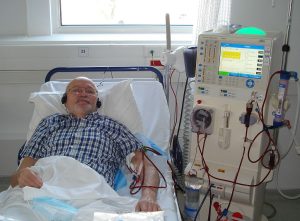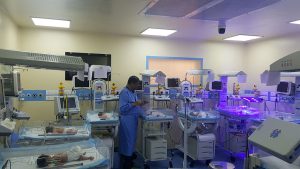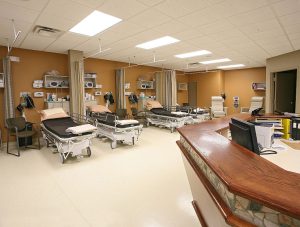9.5 Hospital Units
There are a number of different units in the hospital, and they vary depending on the size of the hospital and the population it provides care for. For example, a rural hospital will likely not have many of the units discussed here, but a large hospital in a city centre will often have them all plus more. The list below will provide a sample and overview of possible units that may be seen in a healthcare setting, but it is not all-encompassing. There is also a discussion of common pathologies and conditions that would cause a patient to be admitted to these units; however, this would be in an ideal setting, and sometimes, due to bed shortages, there may be patients with other reasons for admission present on any given unit.
Hospital Units
Burn Unit: This unit provides care to patients who have suffered advanced and complicated burn injuries (Washington State Department of Health, 2022). These patients have complex and intensive care requirements because a number of complications, including infections, are common when a patient has severe burns.
Cardiology Unit: This unit focuses on care for patients whose main reason for admission is cardiac-related. It would not, ideally, care for a patient in the acute phase of a myocardial infarction but would handle the aftercare once the patient was somewhat stabilized. The unit would also have patients with congestive heart failure, unstable blood pressure, and other cardiac pathologies.
Coronary Care Unit (CCU): This specialized intensive care unit provides care for patients with more complex and unstable cardiac issues. Acute cardiac events such as a myocardial infarction or even open heart surgery would be reasons for admission to this unit (Washington State Department of Health, 2022).
Day Surgery Unit: Patients come to this unit if they are to undergo less-complicated surgeries that do not require an overnight hospital stay. Often patients arrive in the morning and then leave once the procedure is complete and their condition is stable (Whitlock, 2020).
Dialysis (Renal) Unit: Patients on this unit often come in for dialysis, as can be seen in Fig. 9.15, and then leave once the procedure is complete. Often the same patients come in weekly or a few times a week for dialysis. These patients have some level of kidney failure or other pathology, and their kidneys can no longer filter their blood. Some units are designed so the patients stay on the unit because their condition will not allow them to go home between treatments.

Emergency Room (ER): Patients typically access the ER if they need emergency care. The medical professionals on this unit treat a vast array of urgent and acute injuries and pathologies. For example, a patient may have had a motor vehicle accident or a myocardial infarction and requires immediate care.
Gastroenterology Unit: Patients are admitted to this unit if they have a pathology that affects their stomach or intestines. Common conditions could be exacerbations (worsening of symptoms) of Crohn’s disease or ulcerative colitis.
Gynecology Unit: This unit focuses on treating ailments of the female reproductive system. Patients could be experiencing fibroid tumours, exacerbations of endometriosis, uterine bleeding, or other disorders. However, patients would not go to this unit for pregnancy-related issues.
Geriatric Unit: Patients on this unit can be admitted for various reasons, but the main thing they have in common is age. Geriatric patients are generally over the age of 75, though that may vary depending on the policy and specific cutoff age for geriatric status in the local area.
Intensive Care Unit (ICU): In this unit, seriously ill patients receive intense and specialized care such as monitoring and advanced life support (Washington State Department of Health, 2022). The patients are often intubated and have machines breathing for them, as shown in Fig. 9.16. They also receive one-on-one nursing care (Washington State Department of Health, 2022).

Labour and Delivery (L&D) Unit: Patients only come to this unit if they are in labour or at risk for immediate labour. Patients would not come to this unit if they were early on in their pregnancy or for fertility issues. Once the patient has delivered the baby, the mother and infant stay on the unit until stable, but they are often discharged within a day or two at the most.
Medicine Unit: This unit provides care for a vast array of illnesses. Patients would not be treated for conditions that require more complex care, but they often have pathologies such as pneumonia, bronchitis, or mobility issues, or they are waiting for placement in another facility, such as long-term care. Often a patient’s condition does not warrant being on a more specialized unit, but rather the patient may have a number of comorbidities (more than one condition or disease at the same time).
Nephrology Unit: Patients on this unit have a pathology that affects the kidneys. They may require dialysis, which is often done in a dialysis unit (see above), but they may have other pathologies such as kidneys stones, blockages, or other issues with kidney function.
Neurology Unit: There are a number of conditions that can affect the nervous system, and those would be prevalent in patients on this unit. For example, a patient may have had a stroke that was treated in the acute phase but now requires aftercare. Other conditions treated on this unit include head trauma, epilepsy, neuromuscular disorders, or tumours.
Neonatal Intensive Care Unit (NICU): This unit is similar to the ICU (see above) but provides advanced care for newborn infants who require monitoring and advanced life support (Washington State Department of Health, 2022). One type of NICU can be seen in Fig. 9.17.

Oncology Unit: Patients on this unit have been diagnosed with some form of cancer.
Operating Room (OR): This is where surgeries for both in-patients and outpatients are performed; an example of surgery taking place in an operating room is shown in Fig. 9.18 (Whitlock, 2020). If the patient is to remain in the hospital, they will be moved to the recovery room (see below), then to the surgery unit for post-operative care.

Outpatient Department (OPD): This unit treats patients who do not need to stay in the hospital overnight. They have complex needs but can return home in the evening. Patients come to the hospital for some form of treatment, such as rehabilitation, mental health care, or medication, then leave the OPD afterwards (Whitlock, 2020).
Orthopedic Unit: Patients admitted to this unit have issues with their bones or joints. In many cases, they have had an injury and require substantial aftercare and rehabilitation. Patients may also have a chronic anomaly to their bones that requires intervention and treatment.
Palliative Care Unit: This unit provides care for patients at the end of life (Whitlock, 2020). When there are no other treatment options for patients and their health condition is terminal, they can come to this unit, where the focus of care is on patient comfort (Whitlock, 2020).
Pre-admission Clinic (PAC): This area of the hospital is where patients go before surgery and before they are admitted to the hospital, so they can prepare and be educated about the procedure they will be having. The healthcare professionals on this unit ensure that patients are prepared and in the condition needed for surgery to be performed.
Pediatric Intensive Care Unit (PICU): This unit is similar to the ICU (see above), but the advanced care provided is for pediatric patients—children under the age of 18—who require intensive care and advanced life support (Washington State Department of Health, 2022).
Postpartum Unit: This unit admits women who have been on the L&D unit and have given birth. In some cases, either the mother or infant require more long-term care, so they are transferred to the postpartum unit. The infant could have issues with jaundice, feeding, or elimination (bowel or bladder issues), or the mother may have had a complicated cesarean section or difficult delivery.
Psychiatry/Mental Health Unit: There are various kinds of mental health units in a hospital. Some have locked units where patients are under constant observation, others have patients who stay on the unit all the time, and still others allow patients to leave during the day and return in the evening. However, all the patients on this type of unit have some form of mental health diagnosis and are receiving care for that condition.
Pulmonary Unit: Patients on this unit have some form of acute or chronic pulmonary condition; for example, injuries to the lungs such as atelectasis or pleural effusion. They might also have chronic conditions such as uncontrolled asthma, bronchitis, COPD, or inflammation or infection in the respiratory system.
Recovery Room (RR): Patients are taken to this unit after surgery to wait for the anesthesia to wear off; an example of a recovery room can be seen in Fig. 9.19 (Whitlock, 2020). Patients remain in the recovery room until they are able to breathe on their own and respond appropriately to healthcare providers. Once stable, they will either return to the day surgery unit if they are to be discharged that day or they go back to the surgery unit they were admitted to.

Rehabilitation: This area may be in the hospital or is a separate facility, but patients go to rehabilitation to increase their strength and improve their functioning so they can go home (Washington State Department of Health, 2022). After an injury or surgery, patients who requires more time and rehabilitation before they can return home are admitted to a rehabilitation unit or facility.
Specialty Clinics: Depending on the hospital, these clinics can be numerous and vary greatly. There can be diabetes clinics, kidney clinics, blood pressure clinics, and intravenous therapy clinics. There may be other clinics as well, and the number and types of specialty clinics will depend on the size of the hospital and the population they provide care for (Ernstmeyer & Christman, 2021).
Surgery Units: There are many specialty surgery units in a hospital; for example, a thoracic unit that focuses on chest surgeries, or units that focus on neurological or gynecological surgeries. These units will have patients who have had surgeries that relate to the specialty area. There are also general surgery units that will have patients who have had a variety of procedures; however, those procedures will not be specialized or require complex care. Instead, patients on those units will have had routine procedures such as an appendectomy. It is important to note that patients on these units are admitted because they either require surgery or have just had surgery. Also, surgery does not actually occur on these units—the patients leave the unit to go to the OR, as discussed above, then return to the surgery unit for post-op care.
Urology Unit: Patients are admitted to this unit because they have a pathology or anomaly that relates to the urinary system and/or male genitourinary system. Conditions, disorders, and diseases such as prostate disease and renal and bladder dysfunctions may require a patient to be admitted to this unit depending on the severity of the patient’s condition.
Exercise
Attribution
Unless otherwise indicated, material on this page has been adapted from the following resource:
Carter, K., & Rutherford, M. (2020). Building a medical terminology foundation. eCampusOntario. https://ecampusontario.pressbooks.pub/medicalterminology/ licensed under CC BY 4.0
References
Ernstmeyer, K., & Christman, E. (Eds.). (2021). Nursing fundamentals. Chippewa Valley Technical College. https://wtcs.pressbooks.pub/nursingfundamentals is licensed under CC BY 4.0
Washington State Department of Health. (2022). Types of hospital units. https://doh.wa.gov/public-health-healthcare-providers/healthcare-professions-and-facilities/healthcare-associated-infections/hai-reports/types-hospital-units
Whitlock, J. (2020, April 2). Understanding hospital acronyms for floors and units. Verywell Health. https://www.verywellhealth.com/hospital-floors-and-units-3156895
Image Credits (images are listed in order of appearance)
Dializa-02-2021 by Mishu57, CC BY-SA 4.0
Clinicians in Intensive Care Unit by Calleamanecer, CC BY-SA 3.0
Modular NICU with HEPAfilters by Kaveri appala, CC BY-SA 4.0
Operating room by National Cancer Institute, Public domain

